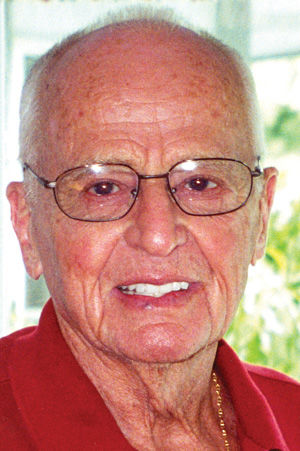Robert J. Lipsitz, pioneer aviator, filmed historic WW II events; dies at 98
Published October 5, 2016
Robert J. Lipsitz, a pioneer aviator and a camera business executive who filmed numerous key battles during World War II, died Thursday, Sept. 29 at his Chesterfield home, surrounded by family. He was 98 and had been in declining health in recent months. He was a lifetime resident of greater St. Louis, most recently of Chesterfield.
Mr. Lipsitz was a larger-than-life person, who got his pilot’s license at age 16. He was able to combine his passion for aviation and movie and still photography during World War II. He was drafted and chose to serve in the Air Force. He was rejected as a fighter pilot because of his color blindness. Instead he was sent to England and ran the photographic division of the 18th Air Force Combat Camera Unit.
Capt. Lipsitz received the Bronze Star for his handling, developing, editing, dispatching and releasing of all motion picture combat films of that unit. Mr. Lipsitz and his team would jump aboard the bombers headed to Germany with handheld cameras to film their missions. Like the great CBS World War II reporter Edward R. Murrow, Mr. Lipsitz and his crew shared the great personal risk of being shot down during his many missions over Germany.
The bombing of Berlin, Dresden, the landing of the Allies at D-Day and dozens more were filmed by Mr. Lipsitz. The films were used to show the results of the missions, and were used to raise money for War Bonds and to encourage the U.S. government to put more effort into the air campaign, which led to the Allies dominating the skies over Germany. His unit followed the troops and filmed the liberation of Paris and the continent after D-Day.
ADVERTISEMENT
After the German surrender, Mr. Lipsitz filmed Winston Churchill’s famous VE Day speech at 10 Downing Street, and was the only American present at that historic event. He reportedly turned down an opportunity for an audience with the king in order to return to his other duties.
Robert Joseph Lipsitz was born in St. Louis on Aug. 1, 1918 in the house his parents build on Waterman Avenue. His father was Dr. Samuel Lipsitz and his mother was Babette Kahn Lipsitz. He had two brothers, Abe Lipsitz (Marion) and Dr. Ellis Lipsitz (Edith).
At an early age Robert and his brothers Abe and Ellis became interested in photography. He worked at the camera department at Stix Baer & Fuller, while his brother repaired cameras to help pay his way through college. Mr. Lipsitz was a graduate of Soldan High School and went to Cadet School at Yale University.
The Lipsitz brothers started selling dark room supplies, which they kept in their mother’s house. The called the company AREL, which were the initials of the three brothers plus their last name.
At 16, Mr. Lipsitz got his pilot’s license, when aviation was still in its infancy. He continued to fly until he was 82. “Flying was his passion,” said his son Larry Lipsitz. “He loved the freedom of the open sky, to go anywhere, anytime, which he would say was only possible in this great country.”
After the war, Mr. Lipsitz returned to St. Louis to rejoin his brothers in his camera business. Over the next decade they built AREL into one of the largest photographic distributors, manufacturers and suppliers in the world.
In 1952, to broaden their sales, they started Kalimar to import products from the Far East. During his first visit to Japan, he developed a 35mm reflex camera that retailed for under $99, which in its first year outsold Canon and Minolta. Kalimar was responsible for importing 22 percent of all the Japanese photographic equipment into the United States.
NASA used his cameras on the 1965 Gemini 5 space flight. They were also the first company to merchandise a product on a package that could be used on a peg hook. Today, this is known as Blister Pack packaging. Later Kalimar expanded into electronics and even jade jewelry.
On one of his trips to Japan, Mr. Lipsitz was accompanied by Louis Loebner, a longtime friend and accountant. “We were there during the High Holidays and I told Bob I was sad not to be going to religious services. He said not to worry and took me to the only synagogue in Tokyo,” Loebner told the Light.
In 1993, Kalimar became a licensee of Mattel to manufacture and sell a worldwide line of Barbie Doll cameras. Mr. Lipsitz ran Kalimar until its sale to the Tiffen Corp in 1999. During his career, he missed only one day of work due to a bad back.
Mr. Lipsitz married Janice Hoffman of Santa Monica, Calif., in 1947. She died in December of 2013. Their surviving children are William (Malu) Lipsitz, Nancy Stein, Larry (Lynne) Lipsitz and Lisa (Bob) Fulsom. Their oldest daughter, Joan Lipsitz Fried, died 13 years ago. Other survivors include 10 grandchildren and four great grandchildren, and Donna Thum, a family friend.
Larry Lipsitz said, “Robert Lipsitz was truly of the Greatest Generation. He was a man with complete determination, who met every challenge to overcome. He never complained, always had a positive attitude, even in his final years when his eyesight was beginning to fail. He loved his family and life to the fullest and was an inspiration to so many. He will be forever in our hearts and will be greatly missed.”
The funeral for Mr. Lipsitz was held last Friday at Berger Memorial Chapel. Burial was private. Rabbi Max Weiman officiated at the service. He offered words of tribute and admiration for Mr. Lipsitz as did his niece, Babette Lipsitz Rittmeyer and his grandchildren.
Memorial contributions preferred to the Joan Lipsitz Fried Memorial Fund, Congregation B’nai Amoona, 324 South Mason Road, St. Louis, 63141, or KME, c/o Rabbi Max Weiman, P.O. Box 32088, St. Louis, 63132.















